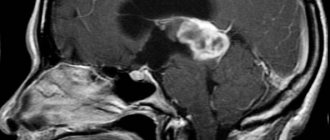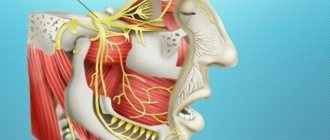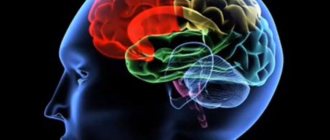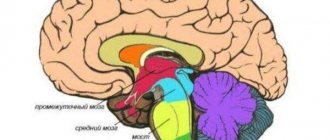Author's rating
Author of the article
Shoshina Vera Nikolaevna
Therapist, education: Northern Medical University. Work experience 10 years.
Articles written
218
Encephalitis of the brain is always dangerous, but when it comes to the herpes virus, which can provoke it, the situation takes an even more frightening turn. Herpes encephalitis often occurs in the first type, which is the most severe for the patient.
From a medical point of view, it should be considered as the most severe consequence of the underlying disease, which attacks the temporal and frontal lobes of the brain. Herpetic viral encephalitis accounts for 10% of all varieties of this disease. It poses the main danger to the child, because it develops most often in children. Let's figure out why this happens and how to deal with it.
Reasons for appearance
Damage to brain structures by the herpes virus is rare. The following can contribute to the activation of the virus and the appearance of this pathology:
- reduced immunity due to AIDS;
- exhaustion;
- severe vitamin deficiency;
- hypothermia;
- tuberculosis;
- rheumatism.
Rheumatism can contribute to the activation of the virus and the appearance of this pathology.
The influence of these unfavorable factors causes a decrease in immunity. The body's defense mechanisms cannot suppress the virus. Once it enters the human body, herpes can no longer be completely eliminated, but if the immune system is in a normal state, the virus remains latent.
Causes of the disease
The causes of herpetic encephalitis are that the herpes simplex virus enters the human body through the oral mucosa, and then moves through nerve cells through the axons of olfactory neurons. But getting into the body does not mean brain damage. Because in unfavorable conditions, the virus goes into a dormant state and is activated only when immunity decreases.
The risk of developing this disease increases if:
- diseases associated with immunodeficiency;
- stressful situations for a long time;
- respiratory infections;
- oncology;
- stroke;
- brain injury.
It mainly occurs as a result of complications of herpes simplex, which manifests itself as rashes in the nasal and oral mucosa. Much less often, viral herpetic encephalitis develops against the background of genital encephalitis.
Today there are two hypotheses for the existence of this disease:
- the resumption of activity of virus particles in the nerve ganglia contributes to its spread along the nerves;
- it lies dormant in nerve cells, from where it reactivates.
Herpes encephalitis develops due to the presence of a virus in the body against the background of severely weakened immunity. Most often, the herpes virus affects the brain in people suffering from HIV infection, as well as those undergoing intensive courses of chemotherapy and radiation therapy, which lead to a significant drop in the body's natural defenses. During therapy for cancer, a decrease in immunity is observed over a long period of time.
The appearance of herpetic encephalitis in children is usually associated with age-related imperfections of the immune system. In infancy, the child is protected from herpes by antibodies that he receives from his mother’s milk. As a rule, in such a situation, the virus in the body is present in a suppressed state, and when the natural defense falls, the first reactivation of the herpetic encephalitis virus occurs. Prevention of infection of newborns, which is now used everywhere, helps to significantly reduce the occurrence of herpes.
There are a number of factors that significantly increase the risk of developing encephalitis, as well as infectious mononucleosis:
- severe form of influenza – after it there is a long period of reduced immunity;
- severe stress or emotional overstrain - they negatively affect both the brain and the immune system;
- chronic infection - its foci constantly weaken the body, and it is unable to protect itself from damage to the nervous system by the herpes virus;
- long-term therapy with immunosuppressants;
- the period after extensive surgery – it is stressful, and the body devotes all its strength to tissue repair to the detriment of its protection;
- the presence of cytomegalovirus - it belongs to the same family as herpes, which provokes brain disease;
- physical overload – they deplete the body, including the immune system;
- poor quality nutrition and lack of sleep - act similarly to excessive physical activity;
- traumatic injuries to the skull - they make brain tissue more susceptible to viral infections and provoke swelling, which increases the risk of inflammation, which is why the disease develops more often.
The penetration of the virus into the nervous system most likely occurs through the nasal mucosa. At the same time, there are cases when the virus is present in the mucous membrane of the oropharynx, but not in the nasal cavity, but inflammation of the tissues of the organ develops.
Clinical picture in children after herpetic encephalitis
What causes the disease?
This type of encephalitis is always provoked by a herpes virus, and most often one that is transmitted by airborne droplets. In severe cases of this disease, herpetic eruptions can spread to the mucous membrane of the nasopharynx, and from here the virus passes through the nerve canals to the cerebral cortex. It is extremely rare that the disease can be caused by the genital form.
The reasons that provoke the appearance of the virus itself are most often associated with a decrease in immunity, especially with:
- stress;
- frequent colds and acute respiratory infections;
- infectious diseases;
- brain injury;
- stroke;
- neoplasms of various types.
Important! In rare cases, the causes of the disease can be individual and directly depend on the condition of the body.
The disease progresses differently in adults and children. The latter may suffer from the encephalitic stage even at the stage of primary infection with the virus. It enters the central nervous system through the olfactory neurons and the nasopharyngeal mucosa. In adults, it can be found in a history or seropositivity.
Most often, this disease is provoked by a non-native strain of the virus: it is a consequence of a secondary infection in which the central nervous system will be affected. Less commonly, herpetic encephalitis is caused by a single strain. This happens when the virus is activated at the genital level and enters the brain through the channels of the nervous system, striking the fossa of the skull.
How is rehabilitation going?
Brain herpes can have extremely adverse consequences. In this pathological condition, neurological disorders may remain after the completion of the acute course of the disease. Complications that often occur with this disease include:
- migraine;
- meningitis;
- decreased mental activity;
- muscle weakness;
- partial memory loss;
- visual, speech and hearing impairments;
- attacks of dizziness;
- epilepsy;
- various mental disorders.
Complications that often occur with this disease include meningitis.
If rehabilitation is not carried out properly, these complications may persist for the rest of your life. If, after eliminating acute symptoms, a person is forced to work and is mentally overtired, takes alcohol or is exposed to other unfavorable factors, the consequences of the viral damage to brain tissue may become more pronounced.
What else to read: Causes and symptoms of herpes in the blood
After herpes of the brain, comprehensive rehabilitation is required. In addition to a healthy diet, it also includes:
- physiotherapy;
- physiotherapy;
- activities aimed at restoring normal brain functioning.
Rehabilitation therapy is carried out in special rehabilitation centers.
If you suspect the presence of a herpetic lesion, urgently seek medical help.
Clinical picture
Symptoms of herpes brain begin to appear against the background of other diseases: external herpes, pharyngitis, stomatitis and other respiratory lesions. The clinical picture begins acutely. The medulla quickly swells and becomes inflamed, cells die and areas of necrosis form. Damage to brain tissue is of various types:
- Diffuse: the entire brain or a large area of it is involved in the process. This pathology is typical for young children.
- Focal: a limited part of the brain is affected.
The pathological process involves gray and white matter. Often the inflammation spreads to the cerebral cortex.
The main symptoms of herpetic encephalitis:
- fever with a significant increase in temperature, sometimes up to 41 degrees;
- Jacksonian seizures - convulsive muscle contractions that begin on one side, but soon cover the entire body;
- nausea, vomiting that does not bring relief;
- paralysis and paresis;
- inability to normally control body movements (see);
- unbearable headaches that are difficult to respond to medications;
- the appearance of delusional states, aggressiveness.
If the course of the disease is very severe, or in the case where no treatment has been carried out, the pathological process spreads to the spinal cord. Symptoms of damage to the latter appear.
The mechanism of development and causes of pathology.
Learn about the symptoms and consequences of the disease.
Symptoms of brain herpes in young children are more severe than in adult patients. Often in the first phase, depression of consciousness quickly occurs, the child falls into a state from which it is difficult to get him out. The negative impact of infection on the brain manifests itself in the form of convulsions of the whole body, up to opisthotonus.
Seizures are very difficult to stop. And even if the child can be brought back to consciousness, there is a high risk of developing problems with written and spoken speech, and some motor skills may be lost. In such patients, memory almost always suffers, especially short-term memory.
How is diagnostics carried out?
Diagnosis of herpes encephalitis of the brain is carried out in a hospital setting. Suspicion of the disease is the reason for hospitalization and initiation of treatment for infection. The methods for detecting violations are as follows:
- examination of cerebrospinal fluid using PCR is the only way to 100% determine the disease, since it will reveal the DNA of the virus;
- electroencephalography – using a special apparatus, the bioelectrical activity of organ cells is determined;
- MRI - allows you to determine the presence of encephalitis, but without identifying the form of the disease.
Nonspecific diagnostic methods include a general blood test, which determines the degree of the inflammatory process, in which an increased content of leukocytes is detected in the blood.
Diagnosis and treatment
The characteristic clinical picture and data from instrumental and laboratory examinations allow an accurate diagnosis. To determine the problem, the following are assigned:
- cerebrospinal fluid puncture;
- PCR;
- CT;
- MRI;
- biopsy;
- general and biochemical blood tests.
Therapy should be carried out in a hospital setting. The patient requires intensive drug treatment. First of all, antiviral drugs are prescribed, including:
- Gerpevir;
- Acyclovir (more details here);
- Virolex;
- Zovirax (more details here).
First of all, antiviral drugs such as Zovirax are prescribed.
The form and dosage of these medications are prescribed by the doctor individually. Among other things, immunomodulatory drugs, corticosteroids and interferons are prescribed to correct the functioning of the immune system.
To stabilize the condition, detoxification therapy can be performed. Medicines may be prescribed to help manage symptoms, including diuretics, anticonvulsants and antipyretics.
In most cases, the prognosis depends on the timely start of treatment.
Treatment methods for herpetic encephalitis
Treatment of herpetic encephalitis must be started immediately, because in its absence, 80% of patients quickly fall into a coma and die, therefore, timely identified symptoms of infection give a person a chance to live. Sometimes the disease develops at lightning speed and is accompanied by rapid swelling of the brain and subsequent cessation of breathing, and if the person still survives, the symptoms develop in the opposite direction, but persistent residual effects remain. In rare cases (1–2% of all patients), a person recovers without consequences.
Treatment of herpetic brain damage takes place in a hospital setting, because the risk of sudden respiratory arrest is very high, and doctors begin drug therapy even without confirming the diagnosis with laboratory tests. The patient is prescribed Acyclovir (in high doses and intravenously) as the main drug, and additional therapy includes the use of antibiotics that can penetrate the blood-brain barrier, immunomodulatory agents (Interferon), and drugs for symptomatic treatment (antipyretics, anticonvulsants, neuroprotectors).
The drug Acyclovir
Herpetic encephalitis is a dangerous disease, the lack of treatment of which can lead to irreversible consequences, therefore, at the first symptoms of its development, you must consult a doctor. Today, scientists are working on creating a universal antiherpetic vaccine, but its effectiveness has not yet been sufficiently studied. The only available method of preventing the development of encephalitis is the regular use of medications that improve the functioning of the immune system.
Treatment of herpes brain is carried out under the supervision of a doctor in a hospital from the very beginning of the development of the disease. If the patient has paralyzed parts of the body or has difficulty breathing, placement in intensive care is indicated. An adult can tolerate herpes more easily than a child, but the risk of death remains.
During therapy, chemotherapy drugs from the antiviral category are used. Patients are prescribed Acyclovir or its analogues Zovirax, Virolex and others. At the beginning of treatment, they must be administered by injection. After stabilization of the condition, they proceed to oral administration of medications.
Photo No. 1 - Virolex tablets, photo No. 2 - Acyclovir injections
1
12
Treatment of herpesvirus is carried out in the intensive care unit in the intensive care unit. The main therapeutic drug is Acyclovir. Other antiviral agents (Famciclovir) are also used. Medicines in large doses are administered intravenously.
Combating complications includes prescribing broad-spectrum antibiotics to prevent the development of a bacterial infection in a bedridden patient. The rest of the therapy is symptomatic. Drip administration of water-salt solutions and glucose is prescribed to maintain brain function, correct the basic balance and detoxify.
For convulsive syndrome, anticonvulsants are used to combat the febrile state. During the recovery period, neuroprotectors, nootropics and vitamins are needed. Depending on the degree of dysfunction of the brain, classes with a speech therapist or rehabilitation doctor may be required. In 1-2% of patients, the disease passes without consequences. In other cases, there are persistent residual effects.
Prevention
Basically, infection with herpetic encephalitis is carried out by airborne droplets, so the set of preventive measures generally coincides with those for a cold, and also includes general recommendations for the prevention of sexually transmitted infections:
- increasing immunity;
- protected sex using condoms;
- avoiding contact with sick people and carriers of the virus;
- taking multivitamins.
It is necessary to understand that this pathology is dangerous and can lead to irreversible brain dynamics and human death.
Forms of the disease
Depending on the localization of inflammatory changes in the brain, the following forms of herpetic encephalitis are distinguished:
- polioencephalitis (mainly gray matter structures are affected);
- leukoencephalitis (white matter suffers more than others);
- panencephalitis (diffuse inflammation involving all cerebral structures).
After brain herpes, complications that are irreversible are highly likely to develop. Children, after suffering from inflammation, suffer from epilepsy, various paralysis, and hydrocephalus develops at an early age.
In adults, complications of herpetic infection are:
- Jacksonian type cramps - they can affect only certain muscle groups or all;
- multiple sclerosis – there is a constant progression of the disorder, which ultimately leads to complete disability;
- Alzheimer's disease;
- dementia – weak-mindedness, which is often observed in old age;
- acquired schizophrenia;
- Parkinson's disease.
Complications
The main consequences of the disease are associated with the fact that persistent focal disturbances in brain activity occur, which can have the following manifestations:
- Impaired mental activity. Most patients experience problems with intelligence after encephalitis. If the disease occurs in childhood, it is fraught with mental retardation, which will negatively affect the overall development of the child.
- Cramps. Quite often, epilepsy develops after encephalitis. This is due to the fact that epileptic foci are formed in the brain, which provoke the appearance of convulsive syndrome. Treatment of this condition is difficult, since the lesions can be quite large.
In order to prevent such phenomena, it is necessary to begin full-fledged treatment in a timely manner, thanks to which the risk of residual effects is reduced to a minimum.
Pathology leads to mental impairment in the child
How does the disease manifest itself?
More than 92% of the entire population of planet Earth is infected with herpesvirus disease. Most of them don’t even know about it, because for most of their lives the virus lies dormant and does not manifest itself in any way.
But when immunity decreases, the virus begins to actively multiply. And if most adults have antibodies to it in their blood, then infants do not have them. Not only children are at risk from this disease: elderly people, whose immunity is reduced due to depletion of the body due to age-related changes, are at risk.
Signs of the first stage of herpetic encephalitis are symptoms inherent in herpes:
- the ectoderm becomes covered with a rash with watery content, especially on the mucous membranes;
- a little later the headache begins;
- fever begins;
- worried about convulsions;
- it becomes difficult to think;
- behavioral habits change;
- the first neurological disorders are observed.
The following symptoms will help identify herpetic encephalitis:
- high temperature, which cannot be brought down even with strong medications;
- the patient is bothered by severe and frequent convulsions;
- vision and hearing may be impaired and/or lost;
- coma.
Individual clinical picture of the disease:
- the eye/eyes may squint;
- sensations of objects splitting;
- the inability to move the limbs on any one part of the body, most often it is this side of the brain that is affected by the virus;
- difficult or impossible to move independently;
- speech becomes incomprehensible, incoherent;
- memory loss, partial or complete;
- auditory and visual hallucinations;
- excitability;
- profuse sweating;
- instability of pulse and blood pressure.
This acute form of the disease can occur in only 5 people per 100,000, but if this happens, the patient is immediately admitted to the intensive care unit. The favorable prognosis largely depends on the following:
- how badly the virus has affected the brain;
- whether the diagnosis was correct;
- how quickly and correctly the therapy was carried out.
If treatment for herpetic encephalitis is not started in a timely manner or is completely ignored, the brain will completely swell, which will lead to death. Even with timely treatment, some negative consequences cannot be avoided:
- neuralgic disorders;
- mental disorders;
- epileptic seizures.
Sluggish course of the disease
The disease becomes chronic due to chronic inflammation of the central nervous system, accompanied by periodic increases in temperature to 37–38 degrees and asthenic syndrome. This condition can last for months, and after about six months, sluggish encephalitis begins with focal brain disorders.
The main symptoms that may occur at the onset of this disease are:
- short-term convulsions;
- resulting paralysis of the muscles of one part of the body;
- muscular dystonia;
- asymmetry of reflexes.
Impaired consciousness in this form, as a rule, does not occur.
Despite the fact that herpetic encephalitis in this form is not violent, as in an acute case, the risk of death is higher. This happens for two reasons. Firstly, the diagnosis can be made quite late, often at the stage of signs of dementia. Secondly, this form is characterized by resistance of the herpes simplex virus to acyclovir, which leads to unproductive treatment.
After an illness, a person in most cases is left with neurological and mental consequences. Their main symptoms:
- paralysis;
- severe fatigue, weakness;
- headaches, dizziness;
- weakened memory and attention;
- impaired coordination of movements;
- dementia;
- visual, hearing and speech impairments;
- enuresis, encopresis;
- drowsiness;
- irritability, aggressiveness.
Although there are cases where the consequences of encephalitis are absent or mild. People could lead a normal life. This is facilitated by the acute form of the disease (not chronic), adequate treatment (quickly started with high doses), the immune status of the body, its ability to recover, and the patient’s age.
As a result of his herpes encephalitis, Clive Wareing developed symptoms of memory loss. His sensory functions, speech and speech understanding are intact. Intelligence remained at the same level. But there was a gap between the transition of information from instant memory and back, and he was only able to remember anything for 30 seconds. Wareing lives in the present tense all the time, not knowing what happened a minute ago or a long time ago.
Certain conclusions can be drawn. Encephalitis of this type is a serious infectious disease that is accompanied by various neurological and psychiatric symptoms of varying severity. The success of treatment depends on the time of contacting a doctor and the type of different course of the disease. After an infection, the likelihood of clinical consequences occurring is high.
Etiology and mechanism of disease development
As already mentioned, herpes simplex encephalitis is caused by the herpes simplex virus (usually the first type - HSV-1), which enters the human body by airborne droplets (less often - household) mainly through the oral mucosa and enters the central nervous system through the axons of the olfactory neurons . The pathogenesis of the disease is not fully understood, but scientists have two theories of its development. The first theory is based on the fact that the virus enters the autonomic ganglia, where it undergoes a reactivation process and spreads throughout all fibers of the nervous system, and the second assumes that the herpes infection enters the fibers of the central nervous system in a latent state and is already there (under the influence of various factors) reactivated.
How does herpes encephalitis occur in children?
The virus can be transmitted to a newborn child during childbirth or in utero, much less often after birth. Signs of encephalitis appear during the first month of life. The rate of development of symptoms depends on the characteristics of the child’s body and term. The most severe signs are recorded in premature infants. Impairment of respiratory function and swallowing reflex may develop, and convulsions may appear. There are no skin rashes.
In older children, a clinical picture is observed that resembles the course of the disease in adults. The prognosis of the disease is not always favorable. The consequences may be:
- mental retardation;
- blindness;
- deafness;
- hydrocephalus;
- muscle spasticity.
Often children who have had the disease remain disabled.
Herpetic encephalitis in children develops in the following situations:
- As a result of the first encounter with the virus in early childhood. Typically, children attending preschool institutions become infected and manifest as herpetic stomatitis and tonsillitis, but in weakened individuals it is possible that a generalized form with brain damage may develop.
- As a result of chickenpox and cytomegalovirus infection in a severe form.
- In case of infection of the fetus at the end of pregnancy (congenital herpes infection) or during childbirth (acquired).
Symptoms in children
The symptoms of encephalitis and meningitis in children over one year of age are similar to those seen in adults. Against the background of ARVI, the child obviously becomes worse, the temperature rises, vomiting occurs, which does not bring relief, a disturbance of consciousness develops in the form of lethargy or agitation, and a severe headache worries. General cerebral and focal symptoms are formed.
In newborns and infants, inflammation of the brain usually develops 5–10 days after infection, which most often occurs from a mother with a clinical diagnosis of genital herpes on the eve of childbirth, during delivery, or from maternity hospital staff.
Herpetic encephalitis in an infant is characterized by the following symptoms:
- Increase in body temperature to 39 - 41°C.
- Bulging of the fontanel.
- Throwing the head back.
- Monotonous strong cry.
- Lethargy or agitation, followed by drowsiness, indifference and loss of consciousness.
- Vomit.
- Pallor or cyanosis.
- Dyspnea.
- Cramps.
- The presence of a bloody subcutaneous rash on the body (red or red-brown in color, which does not disappear with pressure).
Herpes encephalitis of the brain in children is very severe, involving internal organs and often ends in death.
This infectious-toxic lesion of the brain most often occurs with the involvement of the temporal and frontal lobes, where necrotic foci with hemorrhagic tissue impregnation are formed.
The prevalence of certain symptoms depends on the location of the affected area, its extent and the significance of the changes that have occurred in it.
There is a classic triad of symptoms for herpetic encephalitis:
- Fever. A rapid rise in temperature to 39 ° C or more, unresponsive to the action of antipyretics.
- Convulsive syndrome. Jacksonian-type seizures, both involving the whole body and certain parts of it.
- Disorders of consciousness from short-lived oblivion to the deepest coma, from which in 90% of cases the patient does not emerge - it ends in death.
In addition to the classic ones, which occur in all patients without exception, there are also purely individual symptoms, such as:
- dysfunction of the oculomotor nerve with the development of strabismus or double vision;
- hallucinations of a short-term nature (which may be signs of a concurrent central nervous system disease, but require urgent relief regardless of the cause of its occurrence);
- short-term amnesia;
- mental agitation;
- drenching sweat;
- vestibulopathy (unsteadiness when walking);
- monoparesis (indicating a predominant lesion of the temporal lobe);
- speech disorders (aphasia).
Herpetic lesions of the brain (except for the development of typical necrosis in it) can have the character of a pseudotumorous and stem process or encephalomyelitis.
Causes and symptoms
Basically, the herpes virus manifests itself in the form of wounds on the lips, mucous membranes of the eyes, nose, sometimes the mouth, as well as on the skin and genital area. Its treatment does not cause any particular difficulties, since it does not take much time and effort. It is enough to apply a special ointment or gel to the affected area for 2-3 weeks, and soon there will be no trace of the unpleasant disease.
Sometimes, to achieve the desired effect, it is necessary to take antiviral drugs orally for some time. But herpes cannot be completely cured.
It remains in the human body forever, manifesting itself from time to time (in the presence of favorable circumstances).
Its most dangerous manifestation is herpetic encephalitis of the brain. This infectious disease is caused by a simple herpes virus (type 1 or 2), which provokes an inflammatory process. Most often, herpes brain occurs in people with weak immune systems. The risk group is most often children (under 6 years old) and elderly people (after 55 years old).
It is not known exactly why the brain becomes infected with the herpes virus. For its development, the following factors must be present:
- Penetration of the herpes virus into the body, which comes in two types: congenital (when the fetus is infected in the womb) and acquired (enters the body from the external environment through airborne droplets, sexual intercourse and other routes).
- Weakening of the immune system due to one reason or another (due to age, due to a previous illness).
The herpes virus, entering cells (including neurons), exists in them in an oppressed latent state. When the immune system is weakened, it begins to actively multiply and penetrates the nerve fibers into the brain, provoking an inflammatory process in it - encephalitis.
Often herpetic encephalitis is localized in the temporal and frontal parts of the brain. This is where the death of brain cells and the inflammatory process occur.
The most characteristic symptoms for this disease are:
The occurrence of such symptoms may also indicate the presence of other diseases of the central nervous system. In any case, you should consult an experienced doctor.
To treat and rid the body of HERPES, many of our readers actively use a well-known method based on natural ingredients, discovered by Elena Malysheva. We recommend that you check it out.
All encephalitis looks the same...
Most viral encephalitis with a mild course of the disease in both children and adults manifests itself:
- increased body temperature;
- headache;
- nausea;
- drowsiness;
- sensitivity to light.
In severe cases, leading to the appearance of:
- epileptic seizures;
- stiff neck;
- paresis and paralysis.
And in especially severe cases - to impaired consciousness and coma, accompanied by
- leukocytosis;
- an increase in the number of lymphocytes in the cerebrospinal fluid.
Diagnostic measures
According to modern clinical guidelines, the diagnosis of herpetic encephalitis in newborns, children and adult patients is based on the following two methods:
- PCR study of cerebrospinal fluid obtained by lumbar puncture.
- Neuroimaging based on magnetic resonance or computed tomography.
Polymerase chain reaction (PCR) has high sensitivity and specificity for herpes viral pathogens. Such a study of cerebrospinal fluid is recognized by most doctors as the “gold standard” for detecting the disease. It is important to note that if a patient receives a negative PCR test result once while the symptoms of the disease and changes on MRI persist, the analysis must be repeated after three days.
PCR analysis for HSV types 1 and 2 is recommended to be supplemented with magnetic resonance imaging. The method allows the doctor to determine the localization of the inflammatory focus in the central nervous system, as well as the severity of changes in the brain. If MRI is unavailable or impossible, computed tomography or electroencephalography (EEG) may be used. However, these two methods have lower sensitivity and specificity for encephalitis.
In addition to the two indicated methods, the following approaches are used in clinical practice:
- Collection of complaints, as well as histories of the development of the disease. With careful questioning, the attending physician can establish the fact of a recent exacerbation of herpes, which manifested itself in the form of characteristic rashes on the mucous membrane of the lips.
- A clinical blood test reveals lymphocytosis (an increase in the number of lymphocytes responsible for the antiviral response) and an acceleration of the erythrocyte sedimentation rate (ESR).
- A biochemical study reveals an increase in the concentration of fibrinogen and C-reactive protein, which indicates the development of an inflammatory process.
Conducting virological and serological studies (enzyme immunoassay, precipitation reaction) is not recommended due to the duration of the tests and the low information content of the results for the attending physician.
It is important to note that only a doctor should always interpret the data obtained. Attempts to make an independent diagnosis and subsequent self-medication lead to the development of complications and a worsening prognosis for herpetic encephalitis.
How to recognize pathology
The incubation period lasts from 2 to 14 days. After it, a prodromal period is characteristic, in which signs of general malaise, weakness, and decreased performance appear. Herpes acute encephalitis of the brain develops with the following symptoms:
- Feverish state with temperature rising to 39 degrees. Fever is of central origin, and therefore is not controlled by taking antipyretic drugs.
- Headache.
- Jacksonian type seizures. They start with a finger or toe, gradually move to the entire limb, and can reach the face. Another option for the development of a seizure: convulsions from the tip of the tongue move to the face and spread to the right or left limb.
- Impaired consciousness can range from a brief episode to a deep coma. In the latter case, the disease will most likely end in death.
Sometimes convulsions and loss of consciousness precede a rise in temperature. The disease is accompanied by additional neurological signs that do not appear in every patient. Paresis of oculomotor nerves, unilateral paralysis, and various types of aphasia may be observed. Patients confuse words, cannot express their thoughts orally, and their writing technique is impaired.
Symptoms of herpes brain
Signs of herpes development in the brain:
- headache, which intensifies as the pathology develops;
- the occurrence of seizures that are not amenable to drug treatment;
- increase in body temperature to 39-40°C;
- confusion;
- double vision;
- pain when trying to move the eyeballs;
- weakness in the limbs;
- unsteady gait;
- hallucinations;
- memory losses.
When the nerve trunks of the spinal cord are damaged, loss of sensation in the limbs may occur.












